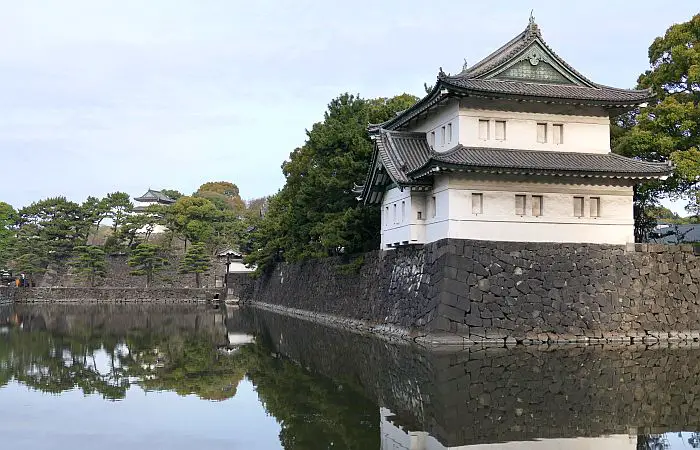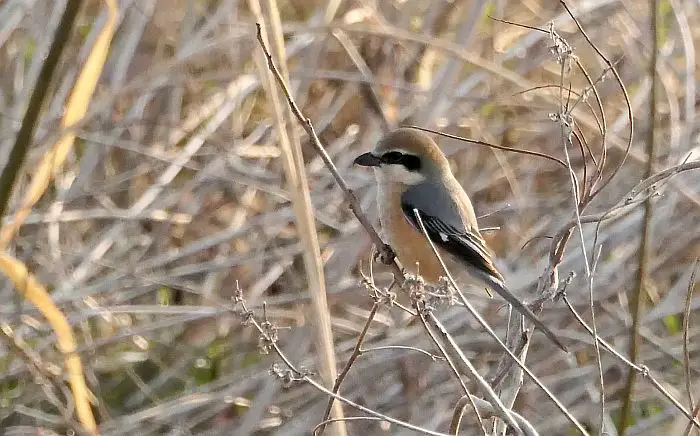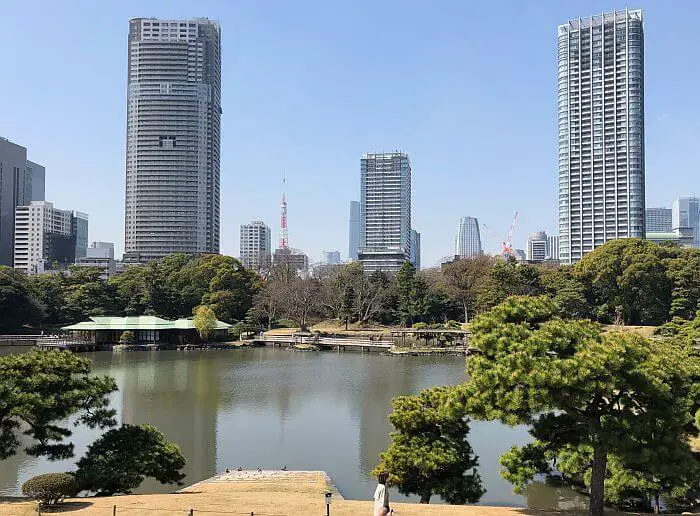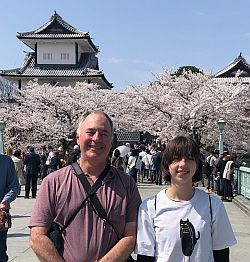Big City Birding in Japan
Story and photos by Sneed B. Collard III
On a father-daughter trip to Japan, a birdwatcher hunts for new additions to his list in leafy parks and riversides in urban Tokyo, Kyoto, and beyond.

I woke early even by my own early bird standards. My 16-year-old daughter, Tessa, still snoozed away in the bed next to me, and our train to Tokyo didn't leave for a few hours, so I thought, What the hell. I dressed, grabbed my binoculars, and headed out into Nagano's empty streets.
Tessa and I had decided to make a quick stop in Nagano simply to check out a new place that we knew little about. Although we held few expectations for this host city to the '98 Olympics, the town proved pleasant enough. We had strolled up a long street to the impressive Zenko-ji Temple, and enjoyed sampling oyaki and other local specialties on the busy block full of food shops and restaurants near Sanmon Gate. One disappointment? An almost total absence of birds.
Waking early the next morning, though, I decided to give Nagano's birds a second chance. With a little research, I determined that no established birding hotspots sat close to our hotel, but Google Maps showed a stream about half a mile away, and I thought, Better go take a look.
I had no trouble finding the river, and was delighted to find walking paths running down both sides of it. Almost immediately, I encountered Dusky Thrushes and Asian House-Martins, but the far side of the river looked even more promising. I made my way to a bridge and began crossing it when suddenly, I spotted something that got my heart pounding: a small, handsome bird perched on a bush, and it definitely seemed to be hunting. Sure enough, as I got closer, I identified it as a species at the top of my Japan "to see" list—a Bull-headed Shrike.

Shrikes are famous for impaling their songbird and insect prey on thorns, nails, barbed-wired fences, and whatever other sharp objects happen to be handy. As I watched, this one flew to some bushes near the streamside—and aroused the ire of a pair of Daurian Redstarts that angrily fluttered up to try to shoo it away. Especially after my relatively birdless previous day, this exciting encounter was the last thing I expected to experience in Nagano, but really, it shouldn't have been. Ever since I arrived in Japan, big cities had been delivering one birding treasure after another.
Not a Birding Trip
Tessa had wanted to visit Japan since we took a family trip to Taiwan when she was only eight years old. My own desires stretched back even further, but the Japan concept seemed abstract, expensive, and only marginally feasible. The more Tessa and I talked about it, however, the more realistic the possibility became. When Japan finally re-opened after Covid, I took the plunge and bought our tickets. I also typed up an itinerary with ample activities and destinations, but to be honest, neither of us felt particularly attached to it. Tessa wanted to learn more about manga and the big city atmosphere of Tokyo, but we both felt excited to just be in Japan, learn about the culture, eat a lot of food, and get a feel for a place that couldn't be more different than our home in Montana.
One particular thing I did want to do? Look for birds. Although I had made clear to Tessa that Japan was not going to turn into a birding trip, I had discovered during the past decade that seeing birds added considerable enjoyment to any adventure. I also harbored an extra incentive for birding Japan: my life list stood at 968 species—perilously close to 1,000. Maybe, just maybe, I thought, this will put me over the top.
Our first morning in Japan, we caught the subway from our hotel near Tokyo Station to Ginza and began walking toward Tsukiji Market, former site of the world-famous fresh tuna auction. We'd eaten breakfast at our hotel, so weren't hungry enough to endure the long lines that formed at the most popular food vendors, but we enjoyed mingling with the crowds and studying the displays of fresh tuna, Japanese knives, custom teas, and other wares for sale. Even as we munched on an indulgence of matcha ice-cream, however, I began contemplating my first serious shot at seeing Japanese birds.

With the help of Tessa's superior teen phone navigation skills, we made our way from Tsukiji to the nearest subway station, and then rode the Oedo Line to Hamarikyu Gardens. We paid a small fee to enter, but even before doing that, I received my first jolt of bird excitement when I espied a white wagtail foraging next to the entry booth. I had enjoyed these birds before in Taiwan and Israel, so the species didn't count for my life list, but it was one of my favorite Asian species and seeing its tail feathers flick up and down put me in a bouncy mood as we passed through the gates.
I asked Tessa if she would like to walk around with me while I looked for other birds. "No, I think I'll just find a bench and draw," she replied, so I left her sitting with her sketch pad while I began exploring the 62-acre oasis in the heart of Tokyo. Following wooded paths and skirting expansive ponds, my assault on 1,000 got off to a promising start as I added common pochard, tufted duck, large-billed crow, brown-eared bulbul, white-cheeked starling, and oriental greenfinch to my life list.
After an hour, however, I hurried back to Tessa, worried she had grown bored. To my relief, she had been enjoying herself perfectly well in the sunshine of a new country, surrounded by trees and grass, and watched over by the glass towers of Tokyo.
That first morning helped Tessa and me establish a companionable routine in which, almost every day, we took time to visit some kind of park or natural area. I would wander off to bird for an hour or so while she sat to draw, sip warm milk tea, and soak up Japan's friendly vibe. These sessions gave her the alone time she needed for reflection and creative endeavors, and me the time to focus on what had become one of my life's great passions. Being a teen, Tessa also liked to sleep in, and I discovered that morning hours gave me a bonus opportunity for "birdsploring"—something I would take advantage of again and again.
Cherry Trees and Ducks in Kyoto
After a few days in Tokyo, we spent a pleasant, rainy weekend in the seaside town of Kamakura, and then headed to Kyoto. The ancient capital lived up to its reputation as the heart and soul of Japan. Even though we shunned most traditional sightseeing, we were blown away by the thousands of red gates of Fushimi Inari Taisha shrine and, even more, by Kiyomizu-dera Temple. Our biggest discovery? The Kamo River, a ten-minute walk from our ryokan. Though far from a pristine, natural river, walking paths ran along both sides of the Kamo, enjoyed by local residents looking for a bit of breathing space.

At first glance, the river didn't actually look that promising for birds. Like the over-channelized river systems in many U.S. cities, this urban river supported scant natural vegetation. As we returned to the river on consecutive days, though, the birds kept surprising me. Ducks are the first birds many birders expect to see in a big city setting, and the Kamo offered a good selection including Eurasian Wigeons and Eastern Spot-billed Ducks. What I didn't expect was how many species Japan shared with North America. Northern Pintails, Mallards, Green-winged Teals, and the biggest surprise, Common Mergansers, also plied the river here, just as they did back home in Montana.
Complementing the ducks were Little Egrets and Gray Herons—the Eurasian analog of our Great Blue Herons—along with the full complement of wagtails to be found in Japan: White, Gray, and Japanese. Majestic black kites soared above the river, and I even spotted Barn Swallows, another species common to the U.S. On our last evening in Kyoto, while Tessa organized her suitcase, I returned to the Kamo one last time. Instead of walking upstream as before, I decided to head downstream, soaking up the relaxing atmosphere of people getting off work against the backdrop of dozens of flowering sakura, or cherry trees, in the evening light.
Suddenly, across the river a small bird with bold wing bars flew along the shore and landed on a rock. Could it be? I asked myself, raising my binoculars. As I focused in on it, I checked off its brown back, clean white breast, and long bill. The bobbing butt cinched it. "Yay! Common Sandpiper!" I said out loud. I had last seen this bird almost nine years earlier in Taiwan, and though it didn't count for my life list, I had especially wanted to find one here. Moments later, a second sandpiper appeared—a perfect Kyoto send off.
Kanazawa Castle and Kenrokuen Garden
Flowering sakura trees continued to greet us when we caught the Thunderbird express train to Kanazawa the next day. I had splurged by booking us a hotel right next to Kanazawa Castle Park, and as soon as we dropped our bags, we rushed off to explore. Even with the thousands of cherry trees we'd already seen, those outside the main entrance of the castle floored us. Not only were the pink blooms full and fragrant, the backdrop of the castle wall behind them transported us straight back to Japan's feudal times.
We took a peek inside the castle itself, but were quickly drawn to the wooded path leading along a ridge above the grounds. As in Kyoto, Black Kites soared and dove only fifty feet overhead, working the thermals coming off of the ridge. Wonderful views of the city spread in all directions—including a great look at Kenrokuen Garden, regarded as one of Japan's most beautiful.
"We should go down there, too," I told Tessa.
As we made our way back to the castle grounds entrance, I spotted a small bird with a black-and-silver head and a red breast. "Stop!" I ordered as I crept forward for a closer look. Sure enough, it was another bird I had especially hoped to see—my first Daurian Redstart. The bird, a glorious silver, black, and orange male, sat perfectly framed in a flowering cherry tree.

I had asked Tessa if it was okay for me to take a solo excursion the next morning, and she had no objection. "I want to explore the park around here anyway," she told me, perhaps betraying a bit of relief that I would be out of her hair for a few hours. So the next day after breakfast, I asked the hotel desk to call me a taxi to a place I had been looking forward to visiting since before the trip—Kenmin Seaside Park. Even my cab driver hadn't seemed to hear of it, but eBird—an essential software tool for birders—listed the place as the best birding hotspot in Kanazawa. More importantly, the park offered a solid opportunity to see shorebirds and pelagic, or open ocean, species.
Plovers on the Dumpy Shore
The cab ride itself piqued my interest as we drove along suburban streets lined with auto repair shops, gas stations, and other businesses reminiscent of an American commercial strip. It made sense, of course, that Japan would have such places, but traveling by train, we hadn't yet encountered them. After thirty minutes, we arrived at the park. My driver's English was almost, but not quite, as appalling as my Japanese, but fortunately, he asked me how I planned to get back after I finished here. It was a good question. After all, the park sat well off of any main boulevards, and I saw nary a bus stop in sight. "Can you come back for me at 11:30?" I asked.
As he pulled away, I set off in the direction of the shoreline, and almost immediately saw Japanese Tits and Dusky Thrushes, and took them as a good sign. Ten minutes later, after a little zig-zagging, I reached the beach.
What I found shocked me. Given the Japanese standard for tidiness, I had expected a relatively natural coastline. Instead, I stumbled onto a shore that had been worked over by decades of industrial expediency. Sand stretched in both directions, but it looked as though it had been deposited by years of dredging operations. More dismaying, the beach lay buried in trash that most likely had washed up on shore. Not a shorebird or gull were to be seen, but a couple of hundred meters offshore, floating next to a manmade breakwater, I did spot a group of ocean birds. I headed toward it, hoping to find another lifer, Japanese Cormorant. Alas, the birds took flight long before I got within binoculars range, leaving me to trudge forlornly through this plastic, metal, rubber, and wooden debris desert.
I decided to aim for a canal or harbor entrance about a kilometer away, hoping I could follow the shore back around to the park. After a couple of hundred meters, though, my eyes suddenly detected movement. Readying my camera, I crept closer, hoping for something interesting. Finally, I raised my binoculars, and my heart lifted. There, among the layer of beach trash, two tiny shorebirds hunted for insects. Their yellow eye rings identified them as my first life birds of the day: Little Ringed Plovers. They were the only two birds I encountered on the entire stretch of beach—survivors in a bird-hostile world.
A Last Shot at Spottings
Our travels continued, to Nagano and then back to Tokyo for the final four days of our trip. For this last stretch, I had booked us a hotel in a more swinging, neon-lit section of Shibuya, and we devoted the following days tracking down delicious meals and filling our extra duffel with clothes and souvenirs to take back home. I did not forget the birds though. On our way to the electronics mecca of Akihabara one morning, we walked through Ueno Park, where I picked up my lifer Black-tailed Gull. We also undertook an unsuccessful search for Mandarin Ducks in Yoyogi Park.

Our last full day in Japan, I sent Tessa out with a hundred bucks, and sternly told her, "Don't come back until you've spent every last yen of it." Then, I grabbed my camera and binoculars and caught a city bus to one final birding destination, Shinjuku Gyoen National Garden. As soon as I paid my fee and entered the grounds, I immediately knew that this would become my favorite big city park of the trip. Once the private estate of a feudal lord, the expansive refuge had become an imperial garden before being opened to the public following World War II. More than 1,500 pink and white sakura greeted me as I meandered over bridges, around ponds, and through trees—including a spectacular grove of towering cedars that completely caught me by surprise.
The bird life proved sparser than I had hoped, but I did see groups of now-familiar Brown-eared Bulbuls and White-cheeked Starlings, and caught a glimpse of what I thought would be my final life bird of the trip—a Pale Thrush high in a tree. As I was walking along the middle pond, however, a large, fast shape caught the edge of my vision, and my heart trampolined. Raptor!
From my pre-trip bird study, I had expected to see a variety of birds of prey in Japan, including buzzards, Eurasian Kestrels, and other raptors, but so far, only Black Kites had put in an appearance. As I watched this bird speed away from me, though, I knew it wasn't anything I had seen so far. I strained to keep my eyes on it, and watched it land in a tree about a hundred meters ahead. I flipped the "On" switch of my camera and quickened my pace, hoping it wouldn't fly before I could ID it.
I was in luck. The bird had obviously grown habituated to the hundreds of humans milling through the park and paid me only scant notice as I halted twenty meters away.

Studying it through my binoculars, though, I was confused. This bird looked familiar—but not like anything I had expected to see in Japan. With its whitish breast and head, and dark band running through its eye, it at first reminded me of an Osprey, but was too big for that and had flown with too much power and purpose. Then, another thought occurred to me. Calling up a bird app on my phone, I punched in another species. "Naw..." I muttered, examining the illustration. Comparing it to what I was seeing in front of me, though, left little doubt. This bird was a Northern Goshawk!
This astonished me for two reasons. One was that I hadn't realized the birds even lived in Asia. The second was that, back in Montana, these birds were very challenging to find, spending the vast majority of their time in forest habitats away from people. Yet here, in the heart of the world's largest metropolitan area, a Northern Goshawk perched pretty much out in the open, staring at me.
Before it could fly away again, I snapped a couple of photos with my lousy travel camera, and then started making my way back to the park entrance. As I did so, I marveled at my luck seeing the bird, and reflected on what a gift it had been. True, it hadn't been a "lifer"—and I was still five birds short of reaching 1,000 species—but the sighting had given me an important insight into the birds of Japan and where they can be found.
The goshawk story, it turns out, didn't end there. Six months after returning from our trip, my son told me that the Scientific Powers That Be had split the Northern Goshawk into two species: American Goshawk and Eurasian Goshawk. The upshot? I hadn't seen a Northern Goshawk. I'd seen a "brand new" bird—one that ended up being a lifer after all. It made the bird all the more special, and put a final exclamation mark on a country both Tessa and I hoped to return to again—and soon.
 Sneed B. Collard III is the author of more than 100 books for children and adults, including the new travel guide, First-Time Japan: A Step-by-Step Guide for the Independent Traveler, available from Mountain Press. Learn more about Sneed at his website www.sneedbcollardiii.com and read of his and his son's birding adventures—including more about Japan—at their blog, fathersonbirding.com.
Sneed B. Collard III is the author of more than 100 books for children and adults, including the new travel guide, First-Time Japan: A Step-by-Step Guide for the Independent Traveler, available from Mountain Press. Learn more about Sneed at his website www.sneedbcollardiii.com and read of his and his son's birding adventures—including more about Japan—at their blog, fathersonbirding.com.
Related Features:
Living in the Moment Along the Kumano Kodo of Japan - Heidi Siefkas
The Shape-shifter and the Architect - Tony Robinson-Smith
The Back Door of the Amazon Jungle in Ecuador - Sneed B. Collard III
Village of The Dolls in Skikoku - Judith Fein
See other Asia travel stories from the archives
Copyright © Perceptive Travel 2021. All rights reserved.
- Why Did You Come to Latvia?! by Dave Seminara
- For a Lifelong Homeless Traveler, Music Marks the Place by Greg Cummings
- Italy Meets Costa Rica in a New Urbanism Community for Neighborly Walkers by Tim Leffel
- Travel Book Reviews by Gillian Kendall
Books from the Author:

Buy Warblers & Woodpeckers: A Father-Son Big Year of Birding at your local bookstore, or get it online here:
Amazon
Amazon UK
Amazon Canada
Kobo Canada

